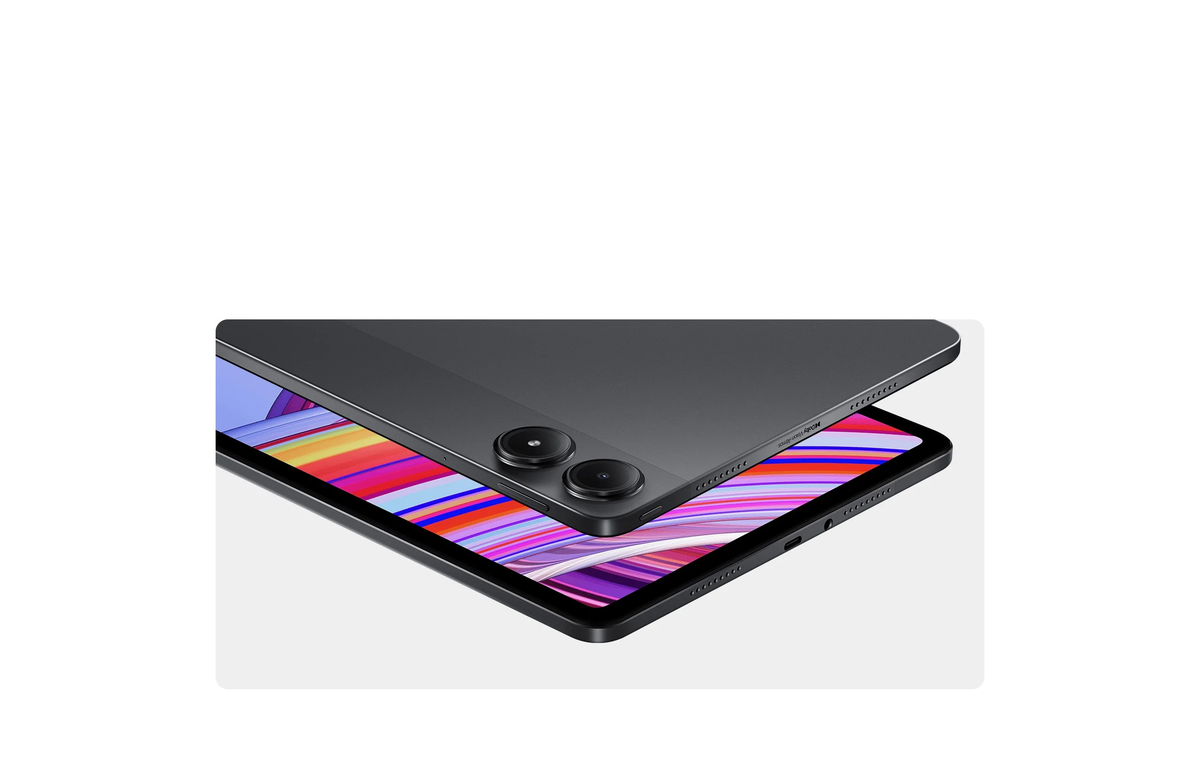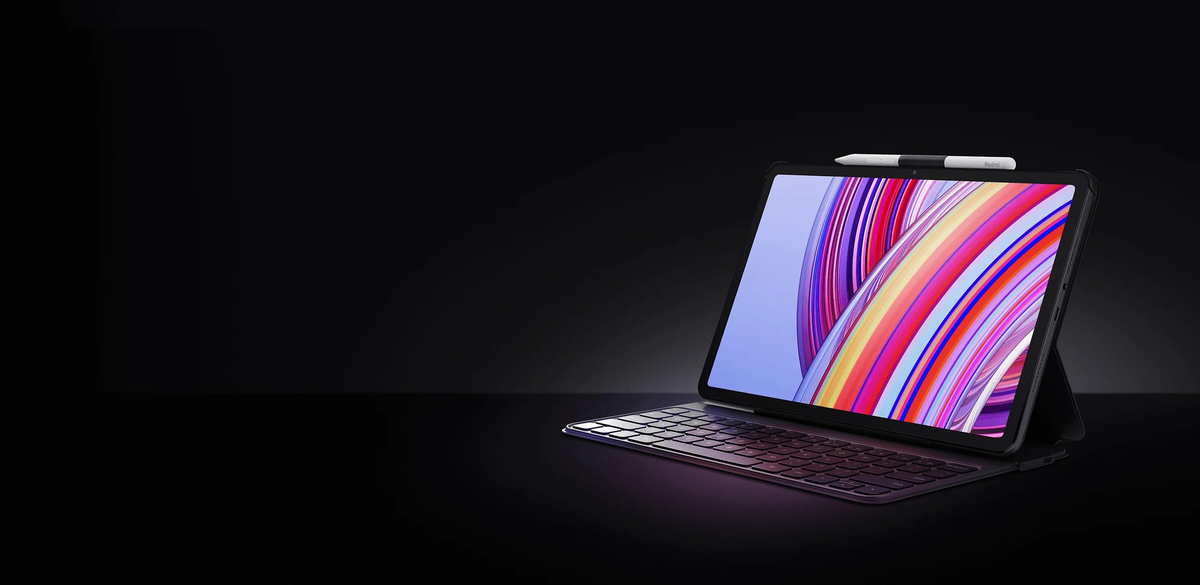Redmi has always kept its focus on the mid-range segment and strengthening it further, the company has launched the Redmi Pad Pro 5G. This latest addition to the Redmi tablet series brings several upgrades over its predecessors, including a more impressive display, enhanced performance, and a larger battery. Let’s find out what the new Redmi Pad Pro 5G has got and what it can offer to the customers.
Design
The Redmi Pad Pro 5G immediately catches our attention with its sleek metal unibody design. The aluminium construction not only lends a premium feel but also provides durability that sets it apart from many competitors in its price range.

Redmi Pad Pro 5G
| Photo Credit:
Special Arrangement
Upon closer inspection, the tablet’s design reveals a thoughtful approach to both form and function. The flat edges and back panel follow current design trends, giving the device a modern and sophisticated look. A standout feature is the dual-ring Deco camera on the rear, which cleverly conceals the antenna. This design choice contributes to the tablet’s clean and elegant appearance, demonstrating Xiaomi’s commitment to blending style with functionality.
The Redmi Pad Pro 5G doesn’t come with an official ingress protection rating. While this isn’t uncommon, users should exercise caution when using the device in environments where moisture or dust might be a concern.
(For top technology news of the day, subscribe to our tech newsletter Today’s Cache)
The Redmi Pad Pro has four speakers, with two on each of its shorter sides. On one side, you’ll find the Power/Lock button, and on the other, there’s a USB-C port and a headphone jack. We liked the hybrid SIM tray in the tab, which was missing in the recently reviewed OnePlus Pad 2. This allows you to expand storage using the microSD card.
Display
The Redmi Pad Pro 5G comes with a 12.1-inch LCD display, a significant upgrade from its predecessors. With a 120 Hz AdaptiveSync refresh rate and a 2560 x 1600 resolution, the screen delivers a sharp 249 pixels per inch. Its 16:10 aspect ratio is ideal for both productivity and media consumption. The display supports 12-bit colour depth, offering vibrant and accurate colors, and is Dolby Vision certified for an enhanced viewing experience with HDR content. Although it lacks HDR10 support, the quality remains good.
The screen reaches a peak brightness of 600 nits, ensuring visibility in bright environments, though it may struggle under direct sunlight. The touch sampling rate of up to 240 Hz, especially with the Redmi Smart Pen, enhances responsiveness, making it perfect for precision tasks like digital art and note-taking. Additionally, Corning Gorilla Glass 3 protection provides reasonable durability against scratches and minor impacts.
Accessories
Xiaomi offers a range of optional accessories that are sold separately. The Redmi Smart Pen is a stylus that supports 4,096 levels of pressure sensitivity, making it an excellent tool for digital artists, note-takers, and anyone who prefers handwritten input. The stylus features convenient shortcut buttons that provide quick access to functions like screenshots and brush switching in compatible apps.

Redmi Pad Pro 5G
| Photo Credit:
Special Arrangement
The other one is the detachable keyboard that effectively transforms the tablet into a more laptop-like device, ideal for productivity tasks. A thoughtful addition is the inclusion of a pen holder, allowing users to keep the Smart Pen close at hand. The keyboard connects to the tablet via pogo pins, ensuring a stable connection without the need for separate charging or pairing.
Software and Features
The Redmi Pad Pro 5G runs on Xiaomi’s new HyperOS 1.0.4, based on Android 14. This new operating system brings a host of optimisations and features tailored specifically for tablet use, enhancing both productivity and user experience.
The interface has been modernised with new colour palettes, wallpapers, and subtle UI curves, giving the system a fresh and contemporary look. Navigation feels intuitive, with smooth animations and responsive touch controls contributing to a polished user experience.
Also, the HyperOS on the pad enhances multitasking, allowing up to four active screens. Intuitive gestures manage floating windows and split-screen functions, perfect for multitasking like taking notes while watching videos. The Conference Tools feature provides a customisable sidebar during video playback, which is ideal for students and professionals.
Accessories like the stylus and keyboard offer extensive customisation options in the settings. Additionally, Xiaomi Interconnectivity features enable seamless file sharing and device control across Xiaomi products, making it a valuable addition for users within the Xiaomi ecosystem and future-proofing the tablet.
Performance
The new Redmi Pad Pro 5G is powered by the Qualcomm Snapdragon 7s Gen 2 chipset, a significant step up from the processors found in previous Redmi Pad models. This octa-core processor, built on a 4nm process, features four Cortex-A78 cores clocked at 2.4GHz and four Cortex-A55 cores running at 1.95GHz. While it may lack a prime Cortex-X core found in some higher-end devices, this configuration still offers substantial performance improvements over its predecessors.
The Adreno 710 GPU handles graphics duties capably, supporting FHD+ resolution. This combination provides smooth performance across a wide range of tasks, from everyday web browsing and document editing to more demanding applications and casual gaming.
Xiaomi offers the Redmi Pad Pro 5G with 8 GB of LPDDR4X RAM, paired with either 128 GB or 256 GB of UFS 2.2 storage. A particularly welcome feature is the support for expandable storage of up to 1.5TB via microSD card, offering ample space for apps, media, and documents without forcing users to rely on cloud storage.
In benchmark tests, the Redmi Pad Pro 5G performs admirably for its class, showing marked improvements in both CPU and GPU performance compared to its predecessors. Geekbench 6 tests reveal impressive scores, with a single-core score of 1033 and a multi-core score of 2996. The GPU score stands at a respectable 1782. Real-world performance is equally impressive, with the tablet handling everyday tasks with ease. The device excels in multitasking scenarios, particularly when utilising the split-screen and floating window features, allowing users to work efficiently across multiple apps simultaneously.
Camera
While cameras are rarely the focal point of tablets, the Redmi Pad Pro 5G offers a competent imaging system that caters well to their typical use cases. Both the rear and front cameras feature 8 MP sensors, with the rear camera benefiting from autofocus capabilities and an LED flash.
The rear camera, while not comparable to flagship smartphone cameras, performs admirably in well-lit conditions. Images captured show good detail and reasonably low noise levels, making it suitable for document scanning, casual photography, or augmented reality applications.
The front-facing camera, optimised primarily for video calls, is a standout feature of the Redmi Pad Pro 5G. It produces images with natural processing and excellent face rendering, making it well-suited for its primary purpose of video conferencing.
Battery
Powering the Redmi Pad Pro 5G is a substantial 10,000 mAh battery, lasting a day comfortably. It comes with 33 W fast charging support. In testing, the tablet can charge from 0 to 50% in approximately 45 minutes, with a full charge taking around 2 hours.
Verdict
The new Redmi Pad Pro 5G represents a significant step forward in Xiaomi’s tablet lineup, offering a mix of premium features at a competitive price point. It successfully addresses many of the limitations of its predecessors while introducing new capabilities that enhance its appeal to a broad range of users, starting at ₹24,999.
While the Redmi Pad Pro 5G may not match the raw performance of high-end tablets, it provides excellent value for its price. The combination of capable hardware, thoughtful software features, and a growing ecosystem of accessories positions it as a versatile device that can adapt to various user needs.



